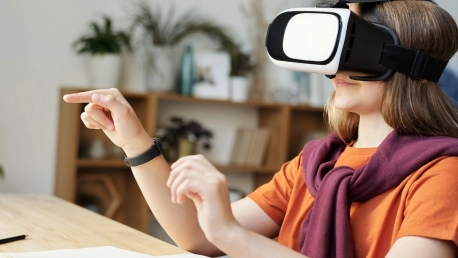Virtual reality (VR) in education can improve online learning and general education solutions, providing students with immersive, hands-on training. In addition, VR technologies offer accessibility for children with learning disabilities and optimizes learner engagement in extracurricular activities.
Furthermore, schools can advance how they approach education, and ensure inclusion and hands-on learning for all their students. Yet, there are many advantages to consider before adopting these technologies; the implementation costs are expensive, and educators must have technical competence.
This article outlines the market size of VR in education, VR applications for education, and its advantages and disadvantages.
The Market Size of VR in Education
The market of VR in education is rapidly expanding, reaching a global value of $11.95 billion in 2023, compared to $8.67 billion in 2022—at a compound annual growth rate (CAGR) of 37.9%. With increased development and penetration of the internet, VR for education will grow in popularity due to how it enhances E-learning.
By 2027, the global market value of VR in education is forecasted to reach $46.14 billion. Additionally, a comprehensive study by the Global Market Estimates confirms that between 2022 and 2027, North America will have the largest market share for VR in education.
How the Education Sector Leverages VR
The education sector has many applications of VR, intending to make learning more accessible, interactive, and personalized to individual students. The most common of these applications include general education, online learning, programs for children with special needs and disabilities, and school field trips. We will explore these various applications below.
General Education
Schools have adopted VR technologies for training in technical, vocational, and soft skills. Traditionally, learners would rely on material, such as books, instructional videos, and demonstrations. However, the evolution of VR in education has welcomed immersive training opportunities, allowing students to gain hands-on experience without the danger of learning new skills. For instance—training students on how to perform chemical reactions in a virtual lab is much safer than in the physical world.
Online Learning
Research from ProsperityForAll states that the global E-learning market is worth over $315 billion. Additionally, this report highlights the popularity of E-learning in businesses, with over 77% of companies incorporating digital training. The study also confirms that digital learning has a 72% success rate, demonstrating why businesses and education institutions alike employ these technologies.
With E-learning widely favored in the education sector, it is no surprise that this promotes the use of VR. Schools and education platforms leverage VR to enhance their overall distance learning experience. Essentially, the growth of E-learning will influence how VR is used in education.
Combining these technologies allow instructors to go beyond conducting lessons through Zoom, Skype, and similar video call platforms. Instead, they can interact and engage with students in virtual classrooms and personalize elements of these virtual spaces according to the needs and behavior of their learners.
Children with Special Educational Needs and Disabilities (SEND)
Students with Special Educational Needs and Disabilities (SEND) require learning tailored to their individual needs, and access to high-quality education. In addition, research confirms that one in every 59 children has one or more learning disabilities (LD), and VR is a viable solution to make education inclusive, accessible, and personalized to these students.
As research confirms, VR experiences allow teachers to gather data on each student’s education requirements and develop customized plans based on these insights. For instance, many VR tools have analytics dashboards to view student engagement rates and overall performance, and teachers can use this data to tailor each child’s learning experience.
Field Trips
Covid-19 restructured many aspects of education, including interactive school activities such as field trips. As a solution, many educational institutions are leveraging VR technologies to provide engaging, educational virtual field trips for their students. Moreover, learners can gain new skills and perspectives that are impossible in the physical world—they can travel to different countries, cultures, historical events, etc.
However, as confirmed by a research paper published on Cite Journal, there are many challenges to virtual fields trips. To start, there is a lack of conclusive evidence that proves virtual extracurricular activities help students improve their understanding of the concepts they learn. Next, the study identified low resolution as another barrier, making it challenging for learners to read and interpret the text. In addition, educators had to receive pre-training to guide students through these experiences, yet this can be costly and time-consuming.
The Advantages of VR Technologies for Learning
Optimized Learner Engagement
VR for education can help schools optimize learner engagement, as students can immerse themselves in an authentic educational experience. Such impactful learning will make it easier to maintain student engagement, and a 2020 PwC survey on VR for employee training confirms this-VR students learn four times faster and are four times more focused. Furthermore, EAB used VR to drive engagement on their student recruitment day. As a result, their inquiries increased by 18%, and they noticed a 27% rise in physical visits after leveraging VR.
Increased Education Accessibility
The most prominent benefit of using VR for education is increased education accessibility for targeted groups of learners with learning disabilities (LD). Cross River Therapy confirms four million children (18 years or younger) have learning impairments. In addition, a separate study states that only 30% of educators feel confident in successfully teaching students with disabilities.
These statistics prove how crucial education accessibility is for learners with LD—teachers need innovative resources to provide consistent training to all groups of students. And VR is a strategic solution to this, as multiple studies confirm that these technologies have helped children on the autism spectrum (among other impairments) improve their social skills by recognizing facial emotions. Additionally, schools can use these technologies to help students learn everyday skills, such as buying items, crossing the street, and interacting with the world around them.
Opportunities to Advance Education
Taking advantage of VR technologies enables schools to advance the methods they use to educate students. These technologies provide learning platforms and institutions with in-depth analytics on each student’s performance, allowing them to refine and personalize their strategies.
In addition, individual-level education means students will benefit from learning tailored to their needs. And, several studies prove how VR helps children with language disabilities, cognitive dysfunctions, and vision impairments, among many others.
The Challenges of VR Technologies for Learning
High Implementation Expenses
PwC confirms that VR can be affordable on a large scale, however, the software and configuration are what costs the most. According to research, VR content production costs between $10,000 and $25,000, while software development is an additional $40,000 to $60,000 investment. Unfortunately, many schools may not have the budgets to accommodate this, and raising these funds could prove difficult.
Lack of Tech-Competence Among Staff
As confirmed by a recent SpringerLink report, if teachers are not data-literate, this will negatively impact their ability to teach children. However, VR is a relatively new technology, and many people do not understand it well enough. Consequently, if schools and learning platforms do not provide proper VR training to their staff, it will be challenging to migrate students to these technologies.
Shortage of Quality Content
As mentioned above, content production for VR in education is costly, and not all educational intuitions can hire software developers to create content. And while schools can try to collaborate with businesses and investors, funding is not guaranteed. Consequently, many schools do not have sufficient resources to develop high-quality content for VR, which can negatively impact their overall delivery.
In Closing
VR technology is popular in the education sector, as these solutions add value to distance learning, special education, general education, and extracurricular activities. Additionally, VR in education can optimize learner engagement, increase education accessibility and provide opportunities to advance education.
On the other hand, not all schools can afford to implement these technologies, develop quality content or provide tech training to their staff. Yet, VR for education continues to grow rapidly and globally, with a promising future market value.









